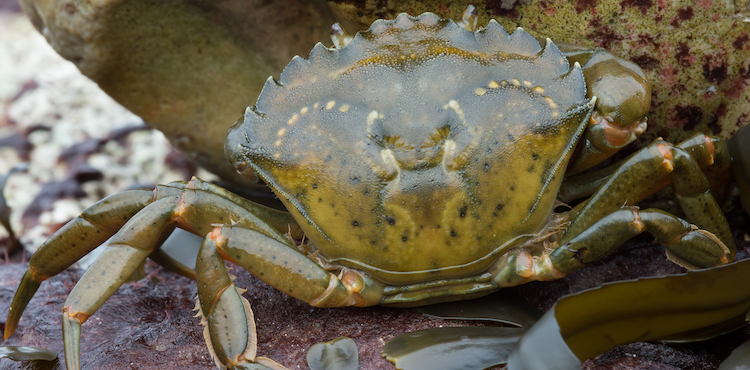
Crabs are tasty creatures of the sea. They crawl and swim on the ocean floor searching for food and hiding spaces. But how can we catch them without diving into the ocean and searching for them? We all want to catch some crabs when we are boating or fishing in the ocean during the day. Crabbing is all about location and tide, how you present your bait, the crab trap, and identifying your crab.

Author Montagu Lee Crabbing
Locating Dungeness Crabs
Location is a major part of finding crabs. Dungeness crab is the preferred target, but there is also red rock crab around the Salish Sea. Dungeness crabs love eel grass with sand and slow-moving water. Eel grass areas tends to trap feed and also provide hiding spots away
from ocean predators. The slow-moving water brings in feed to the crab area. Sometimes slow-moving water is hard to find around the strait but an hour before and after slack tide will provide you that slower-moving water for the crab to move more easily into your trap. In some areas, incoming tide has less tide current for the crab to fight against. Also, the incoming tide provides more salinity within the area, and crabs prefer salty water. Dungeness crab can be found as deep as 300′. Generally we can fish them from 10′ to 100′. Make sure you have enough trap line for the tide swing. The outgoing tide sometimes has more current, which pulls your gear deeper. The extra trap line helps your odds of finding your trap again.
Bait For Crabbing
Having good bait is key, but presenting correctly will get them into your trap. Generally, fresh chicken, salmon, rockfish, lingcod, and meat are good choices for bait. You also need a good scent trail to invite the crabs to your trap. Having some prawn/crab pellets or canned tuna cat food will help. You want to present that bait at the bottom and center of your trap. Why bottom? Crabs will climb to the top of your trap rather than coming inside to feed it if it’s close to the top of the cage. The same thing happens if the bait is close to the side of your trap. Having the bait at the bottom requires them to commit to going inside the cage to get that bait. Putting fish into a bait cage or bait sack will help make your bait last longer in the trap. The chewier bait tends to help keep the crab in the trap longer before they search for ways to get out of the trap.
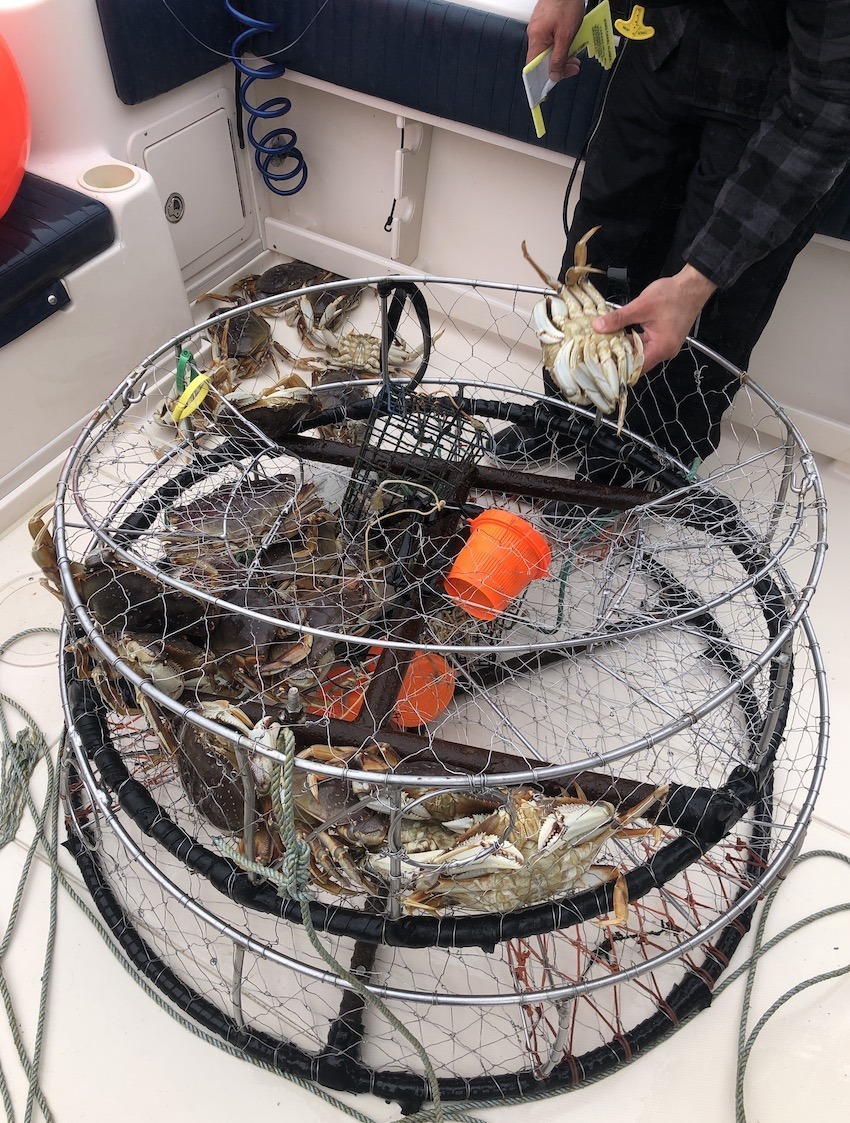
Baited Crab Trap
Crab Traps
There are many different kinds of crab traps out on the market, but the cage trap is what we use off the boat. There are commercial stainless steel and sportfishing crab traps, and we tend to use the sportfishing crab traps due to cost. An easy trap door access for crab
is the key to get more crabs. If the crab finds it hard to get into the bait, it will leave crabby. But when a crab gets into the trap and starts eating the bait, it creates a feeding frenzy. Other crabs will come join the feast. So look for a trap door that opens without much effort but still closes so crabs won’t get out. Now remember about tide current, which might be an issue for some sport crab traps due to their light weight. Adding a zinc clip-on or strapping some weight at the bottom of the trap will help hold it to the seabed.
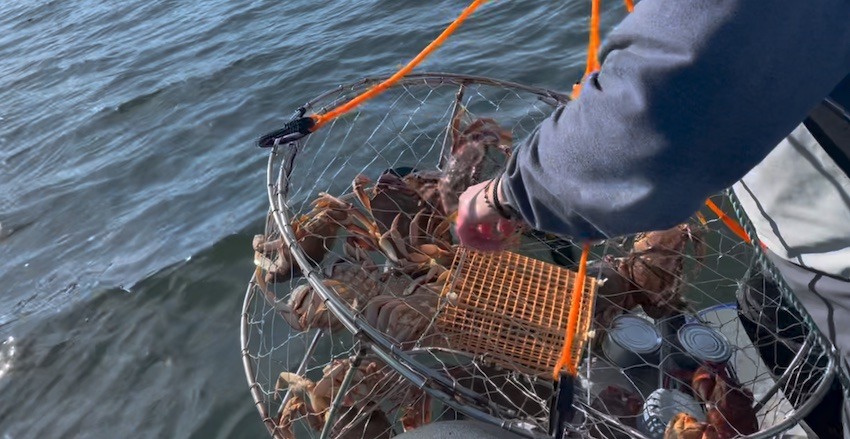
Pulling the trap
Crab Floats
DFO notes that, “For April 1, 2023: Floats attached to crab traps must be bullet shaped cylindrical floats a minimum of 27cm in length and 12cm in diameter. Typically these are foam floats which can be found at most tackle retailers.”

Aliah Hart setting up traps for the season—fresh bright paint, name and phone number clearly marked on a bullet float.
Male vs. Female Crabs
After pulling your trap out of the water and seeing crabs in the cage, you have to release the female and undersized crabs. How do you know which is female or male? When you flip the crab bottom side up, you can see a piece of shell flap in the center of the crab’s belly. If the shell flap is narrow and pointed like a pyramid, it is a male. If the shell flap is wide and rounded like a bee hive, it is a female. Please release all female crabs, so in the future we can have more crabs to harvest. Please also release each undersized crab back into the area where you caught it.
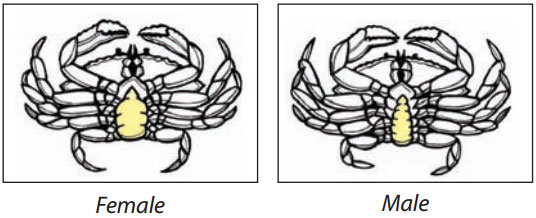
Male vs. female crab-image courtesy Government of Canada
Dungeness crab’s legal size is 165 mm from point to point. Red rock crab is 115 mm from point to point. Always check the regulations, as limits and sizes can change.
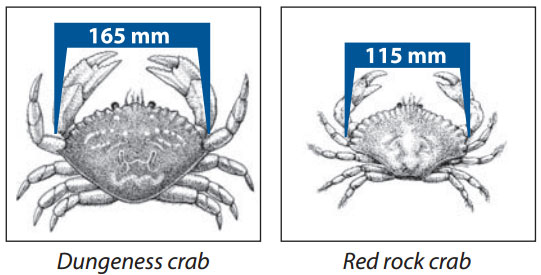
Dungeness Crab Vs Red Rock Crab—image courtesy Government of Canada
Also note that when transporting crab, the shell (carapace) must remain intact so that the size of your crab can be checked. DFO Regs state, “The shell of any sport-caught crab must stay attached to the body until the crab arrives at your ordinary residence”.
European Green Crab
If you happen to find green crab in your trap, this is an invasive species that should be reported. See this article for details on European Green Crab.
Final Crabbing Thoughts
Look for those eel grass spots with sandy bottoms and slow-moving water, and you will find crab. Be safe around ropes and don’t stand on top of the rope when dropping a trap down. Also be aware of your trap line and motor prop when pulling your trap up.
If you suspect someone is illegally crabbing or pulling someone else’s trap, report violators by calling 604-607-4186 in Vancouver, or the toll-free Observe, Record and Report number: 1-800-465-4336.

Crab dinner is served!
Visit the Store
$34.99
$34.99
Featured Catch

Joel Unickow halibut (Photo: Rob Frawley Lucky Strike Sportfishing Tofino)
